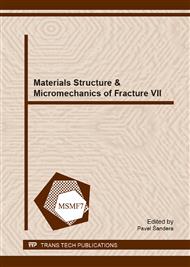p.606
p.610
p.614
p.618
p.622
p.627
p.631
p.635
p.639
Standing Contact Fatigue Analyse of Steels with Different Microstructures
Abstract:
A Standing Contact Fatigue (SCF) test set up has been developed in order to facilitate quick testing of contact fatigue resistance of material surfaces. In this method the sample is pressed against a hard ball rapidly and the resulting crack formation is studied in order to evaluate the SCF resistance. Induction hardened surfaces of cam-ring steel and steels with pearlitic, martensitic, bainitic, ausferritic and quench and tempered microstructures have been studied. Characterization was performed by optical microscopy, scanning electron microscopy and hardness measurements. Ring-cone cracks were found at the edge of the indentations but inside the indent in the surface hardened cam-ring steel samples. Sectional views revealed that these cracks also grow underneath the indentation. Radial cracks were found in non-surface hardened samples. The test of the SCF resistance of steels with different microstructures showed that the ausferritic microstructures tested shoved better SCF resistance than the quench and tempered samples with similar hardness. A comparison between different tempering temperatures of surface hardened steels showed that samples tempered at the higher temperature 240 °C resulted in better SCF resistance.
Info:
Periodical:
Pages:
622-626
Citation:
Online since:
November 2013
Keywords:
Price:
Сopyright:
© 2014 Trans Tech Publications Ltd. All Rights Reserved
Share:
Citation:


